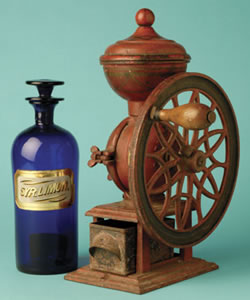As difficult as it may be to believe now, medicine didn’t always come packaged in easy-to-swallow gel caplets or little white pills. In the 19th and early 20th centuries, pharmacists stocked dried herbs and other natural botanical ingredients and ground them into the appropriate medicinal concoctions to be dispensed to ailing customers.
Pharmacists would have placed white birchbark, Canadian hemp, acacia bark, rhubarb root and a variety of other curative substances into the bowl under the lid of this mill, cranked the wheel several times, and collected the result in the small tin drawer at the bottom of the apparatus. In most cases, they would have added the therapeutic blends to ointments or liquid tinctures.
This particular drug mill comes from the Faculty of Pharmacy’s museum, and features a hand-painted Star of David on the lid. It was probably used in a Jewish pharmacy in Ontario in the 1800s. The edge of the wheel bears a simple, decorative graphic design – which goes to show that art and medicine have long made fine bedfellows.
Recent Posts
U of T’s Feminist Sports Club Is Here to Bend the Rules
The group invites non-athletes to try their hand at games like dodgeball and basketball in a fun – and distinctly supportive – atmosphere
From Mental Health Studies to Michelin Guide
U of T Scarborough alum Ambica Jain’s unexpected path to restaurant success
A Blueprint for Global Prosperity
Researchers across U of T are banding together to help the United Nations meet its 17 sustainable development goals





